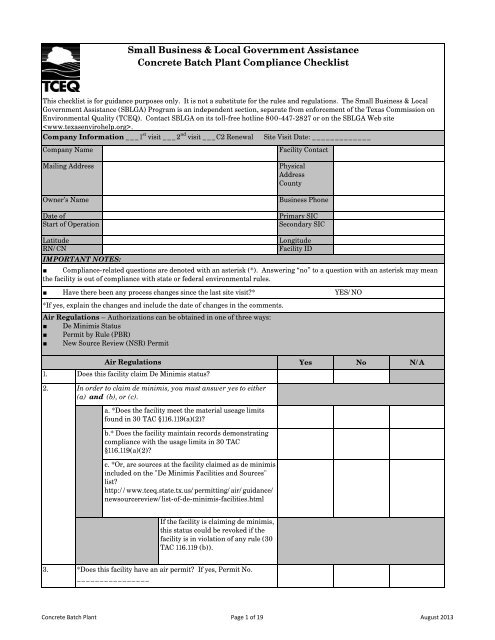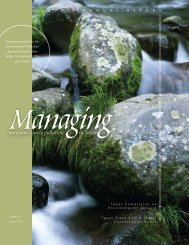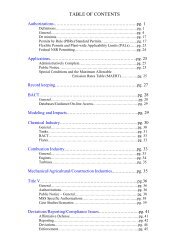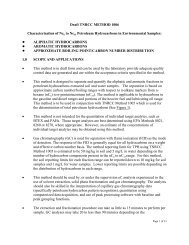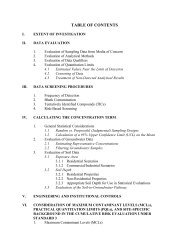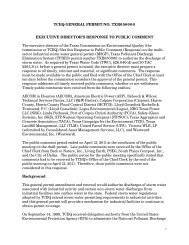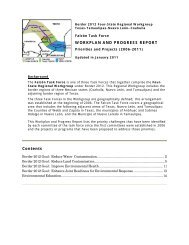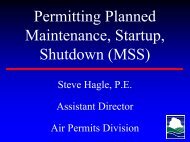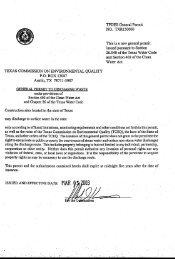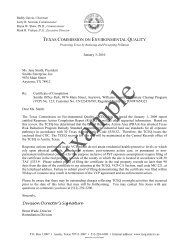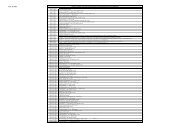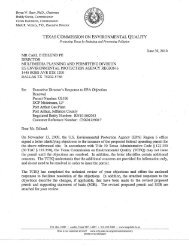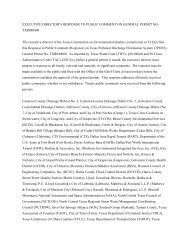Concrete Batch Plant Compliance Checklist - TCEQ e-Services ...
Concrete Batch Plant Compliance Checklist - TCEQ e-Services ...
Concrete Batch Plant Compliance Checklist - TCEQ e-Services ...
Create successful ePaper yourself
Turn your PDF publications into a flip-book with our unique Google optimized e-Paper software.
Small Business & Local Government Assistance<br />
<strong>Concrete</strong> <strong>Batch</strong> <strong>Plant</strong> <strong>Compliance</strong> <strong>Checklist</strong><br />
This checklist is for guidance purposes only. It is not a substitute for the rules and regulations. The Small Business & Local<br />
Government Assistance (SBLGA) Program is an independent section, separate from enforcement of the Texas Commission on<br />
Environmental Quality (<strong>TCEQ</strong>). Contact SBLGA on its toll-free hotline 800-447-2827 or on the SBLGA Web site<br />
.<br />
Company Information ___1 st visit ___2 nd visit ___C2 Renewal Site Visit Date: _____________<br />
Company Name<br />
Facility Contact<br />
Mailing Address<br />
Owner’s Name<br />
Date of<br />
Start of Operation<br />
Physical<br />
Address<br />
County<br />
Business Phone<br />
Primary SIC<br />
Secondary SIC<br />
Latitude<br />
RN/CN<br />
Longitude<br />
Facility ID<br />
IMPORTANT NOTES:<br />
■ <strong>Compliance</strong>-related questions are denoted with an asterisk (*). Answering “no” to a question with an asterisk may mean<br />
the facility is out of compliance with state or federal environmental rules.<br />
■ Have there been any process changes since the last site visit?* YES/NO<br />
*If yes, explain the changes and include the date of changes in the comments.<br />
Air Regulations – Authorizations can be obtained in one of three ways:<br />
■ De Minimis Status<br />
■ Permit by Rule (PBR)<br />
■ New Source Review (NSR) Permit<br />
1.<br />
2.<br />
Air Regulations<br />
Does this facility claim De Minimis status?<br />
In order to claim de minimis, you must answer yes to either<br />
(a) and (b), or (c).<br />
a. *Does the facility meet the material useage limits<br />
found in 30 TAC §116.119(a)(2)?<br />
b.* Does the facility maintain records demonstrating<br />
compliance with the usage limits in 30 TAC<br />
§116.119(a)(2)?<br />
c. *Or, are sources at the facility claimed as de minimis<br />
included on the "De Minimis Facilities and Sources"<br />
list?<br />
http://www.tceq.state.tx.us/permitting/air/guidance/<br />
newsourcereview/list-of-de-minimis-facilities.html<br />
Yes No N/A<br />
If the facility is claiming de minimis,<br />
this status could be revoked if the<br />
facility is in violation of any rule (30<br />
TAC 116.119 (b)).<br />
3.<br />
*Does this facility have an air permit? If yes, Permit No.<br />
________________<br />
<strong>Concrete</strong> <strong>Batch</strong> <strong>Plant</strong> Page 1 of 19 August 2013
4.<br />
5.<br />
6.<br />
*If yes: Does the facility comply with all permit conditions?<br />
(Use comments section)<br />
*Does the facility claim a Permit by Rule (PBR)?<br />
If yes: Does the facility meet all requirements of the PBR(s)<br />
claimed? See below.<br />
*a. 106.141 - <strong>Batch</strong> Mixers<br />
*b. 106.265 – Hand-held and Manually Operated<br />
Machines<br />
*c. 106.412 – Fuel Dispensing<br />
*d. 106.472 – Organic, Inorganic Liquid Loading and<br />
Unloading<br />
*e. 106.512 - Stationary Engines and Turbines<br />
*f. Other/Previous PBR:<br />
______________________<br />
*g. Other/Previous PBR: ____________________<br />
7.<br />
Does the facility meet the requirements in 30 TAC §106.4?<br />
8.<br />
9.<br />
10.<br />
*Does the facility maintain records that demonstrate<br />
compliance as required by 30 TAC §106.8 for all PBRs?<br />
*Does the facility avoid being a nuisance (noise, dust, odor,<br />
etc)? (30 TAC §101.4)<br />
*Is the facility a major source?<br />
* If yes, does the facility have a federal operating<br />
permit?<br />
Unauthorized permanent concrete batch plants operating on or after 1985 may obtain air<br />
permit approval by either of the two following standard permits:<br />
■<br />
Air Quality Standard Permit for <strong>Concrete</strong> <strong>Batch</strong> <strong>Plant</strong>s (CBP) effective July 10, 2003; or<br />
11.<br />
12.<br />
■ Air Quality Standard Permit for <strong>Concrete</strong> <strong>Batch</strong> <strong>Plant</strong>s with Enhanced Controls (CBPEC) effective<br />
August 16, 2004<br />
*Is the facility currently registered under one of the standard<br />
permits for concrete batch plants in accordance with 30 TAC<br />
§116.611?<br />
*Are records maintained on-site to show hourly site production<br />
for a rolling 24-month period while the plant is in operation?<br />
13.<br />
*Are records maintained on-site for a rolling 24-month period<br />
for each hour of plant operation to indicate the site production<br />
does not exceed 300 cubic yards per hour?<br />
14.<br />
*Are all cement/fly ash storage silos and weigh hoppers vented<br />
to a fabric or cartridge filter systems?<br />
15.<br />
*Are the fabric/cartridge filter systems and suction shroud<br />
operated properly with no tears or leaks?<br />
<strong>Concrete</strong> <strong>Batch</strong> <strong>Plant</strong> Page 2 of 19 August 2013
16.<br />
17.<br />
*Are all filter systems designed to meet at least 0.01 grain/dry<br />
standard cubic foot outlet?<br />
*Do all filter systems and mixer/truck loading control devices<br />
meet visible emissions performance standards?<br />
18.<br />
Are cement and/or fly ash silo filter exhausts equipped with<br />
sufficient illumination to observe visible emissions<br />
performance if the silo(s) are filled during non-daylight hours?<br />
19.<br />
*Are the conveying systems to and from the silos totally<br />
enclosed and maintained with no tears or leaks?<br />
20.<br />
*During cement/fly ash storage silo(s) filling, except for<br />
connecting or disconnecting, are visible emission standards met<br />
for the conveying system?<br />
21.<br />
*Is a warning device installed on each bulk storage silo to alert<br />
operators in sufficient time so the loading operation can be<br />
stopped prior to over-filling and failure of the filter systems?<br />
22.<br />
*Is each road, parking lot, or other area at the plant site that is<br />
used by vehicles paved with a cohesive hard surface and<br />
properly maintained, cleaned, and watered so as to minimize<br />
dust emissions?<br />
23.<br />
24.<br />
*Are dust emissions from all stockpiles minimized at all times<br />
by sprinkling with water, dust-suppressant chemicals, or<br />
covers?<br />
*Are all material spills immediately cleaned up and contained<br />
or dampened so dust emissions are minimized?<br />
25.<br />
*Will all batch trucks and material delivery trucks remain on<br />
paved surface when entering, conducting primary function, and<br />
leaving the property?<br />
*a. If not will all in-plant roads be treated with dustsuppressant<br />
chemicals or water?<br />
26.<br />
*Is a suction shroud or other pickup device installed at the<br />
batch drop point (or drum feed)?<br />
*a. CBP – Does it vent to a fabric or cartridge filter<br />
system with a minimum of 4,000 actual cubic feet per<br />
minute (acfm) of air?<br />
*b. CBPEC – Does it vent to a fabric or cartridge filter<br />
system with a minimum of 5,000 acfm of air?<br />
27.<br />
*CBPEC – Is the bag filter and capture system properly<br />
designed to accommodate the increased flow from the suction<br />
shroud and achieve a control efficiency of at least of 99.5%?<br />
28.<br />
*Is the suction shroud baghouse exhaust located at least 100<br />
feet from any property line?<br />
<strong>Concrete</strong> <strong>Batch</strong> <strong>Plant</strong> Page 3 of 19 August 2013
29.<br />
Are stationary equipment, stockpiles, and vehicles used at the<br />
plant, except for incidental traffic and vehicles as they enter<br />
and exit the site, located or operated:<br />
*a. CBPEC - more than 100 feet from any property<br />
line?<br />
*b. CBP – more than 25 feet from any property line for<br />
facilities with production rates of 200 cubic yards per<br />
hour or less and more than 50 feet from any property<br />
line for facilities with production rates more than 200<br />
cubic yards per hour and less than or equal to 300<br />
cubic yards per hour?<br />
*c. Specialty <strong>Plant</strong> <strong>Concrete</strong> <strong>Batch</strong> <strong>Plant</strong> (SPCBP) -<br />
more than 25 feet from any property line for facilities<br />
with production rates less than 30 cubic yards per<br />
hour?<br />
*d. Temporary <strong>Concrete</strong> <strong>Batch</strong> <strong>Plant</strong> (TCBP) - more<br />
than 25 feet from any property line for facilities with<br />
production rate less than or equal to 200 cubic yards<br />
per hour?<br />
*e. Temporary <strong>Concrete</strong> <strong>Batch</strong> <strong>Plant</strong> (TCBP) - more<br />
than 50 feet from any property line for facilities with<br />
production rate more than 200 cubic yards per hour<br />
and less than or equal to 300 cubic yards per hour?<br />
30.<br />
In lieu of meeting the distance requirements above:<br />
*a. Is each road, parking lot, and other traffic<br />
bordered by dust-suppressing fencing or another<br />
barrier at least 12 feet high?<br />
*b. Are stockpiles contained within a three-walled<br />
bunker, which extends at least two feet above the top<br />
of the stockpile?<br />
31.<br />
*CBPEC only – Is the plant located in an area subject to<br />
municipal zoning regulations? (If there are no municipal zoning<br />
regulations, the central baghouse will be located at least 440<br />
yards from any building used as a single of multi-family<br />
residence, school or place of worship.)<br />
Air Regulations (30 TAC Chapter 101) –<br />
Emission, Maintenance, Start-up, Shutdown<br />
Yes No N/A<br />
32.<br />
33.<br />
34.<br />
*Does the facility track all reportable and non-reportable<br />
emission events and report them to <strong>TCEQ</strong> by March 31 of each<br />
year? (30 TAC §101.201)<br />
*Does the facility track all reportable and non-reportable<br />
scheduled maintenance, start-up, and shut-down activities and<br />
report them to <strong>TCEQ</strong> by March 31 of each year? (30 TAC<br />
§101.211)<br />
Is the facility required to submit an annual emissions inventory<br />
as specified in 30 TAC §101.10?<br />
<strong>Concrete</strong> <strong>Batch</strong> <strong>Plant</strong> Page 4 of 19 August 2013
35.<br />
*Are these records maintained for a minimum of 5 years?<br />
36.<br />
37.<br />
Air Regulations (Federal and 30 TAC Chapters<br />
111 and 113 Requirements)<br />
*Does the facility comply with 30 TAC Chapter 111<br />
requirements? (Control of Air Pollutants from Visible<br />
Emissions and Particulate Matter)<br />
*Does the facility comply with any applicable 30 TAC Chapter<br />
113 requirements? (Standards of Performance for HAPs)<br />
Yes No N/A<br />
38.<br />
*If the facility is a source of hazardous air pollutants (HAPs),<br />
do they comply with any applicable National Emission<br />
Standards for Hazardous Air Pollutants (NESHAP)?<br />
http://epa.gov/ttn/atw/mactfnlalph.html<br />
A list of hazardous air pollutants can be found at<br />
http://www.epa.gov/ttn/atw/188polls.html<br />
39.<br />
Petroleum Storage Tanks (PST) Regulations<br />
*a. Are all regulated USTs and ASTs registered with<br />
the <strong>TCEQ</strong>?<br />
*b. Are all USTs containing motor fuel self-certified?<br />
Yes No N/A<br />
40.<br />
41.<br />
42.<br />
43.<br />
44.<br />
45.<br />
*c. Is a <strong>TCEQ</strong> delivery certificate posted at the facility<br />
for all motor fuel USTs?<br />
*d. Has the facility designated an A, B, & C Operator<br />
for its USTs?<br />
*e. Does the facility have appropriate signage if a<br />
trained operator is not present?<br />
*Are the appropriate records being maintained for the<br />
recordkeeping requirements of 30 TAC §334.10?<br />
*Have all motor fuel USTs been properly labeled?<br />
*If the facility is involved in retail fuel sales, do they keep<br />
required Inventory Control records?<br />
*Do all USTs meet <strong>TCEQ</strong> requirements for corrosion<br />
protection, spill and overfill prevention, leak detection,<br />
financial assurance, etc.?<br />
Do any of the following conditions exist regarding storage<br />
tanks? Check all that apply.<br />
a. Total aboveground capacity of the facility is greater<br />
than 1,320 gallons?<br />
b. Total capacity in underground tanks is greater than<br />
42,000 gallons?<br />
*If the answer to (a.) or (b.) above is yes, does the facility have a<br />
Spill Prevention Control & Countermeasure (SPCC) Plan?<br />
46.<br />
*Does the facility have an exemption for Stage II or meet Stage<br />
I and Stage II requirements, if necessary?<br />
<strong>Concrete</strong> <strong>Batch</strong> <strong>Plant</strong> Page 5 of 19 August 2013
47.<br />
*Does the facility have documentation to support an exemption<br />
from or compliance with Stage I and Stage II requirements?<br />
48.<br />
If the facility has had a reportable release or suspected release,<br />
* has the release been reported to the <strong>TCEQ</strong> within 24<br />
hours. (Chapter 334.72)<br />
* has the system been tightness tested within 30 days?<br />
(30 TAC §334.74)<br />
49.<br />
*Does the facility have documentation to support an exemption<br />
from or compliance with Stage I and Stage II requirements?<br />
Waste Regulations (General Requirements)<br />
Yes No N/A<br />
50.<br />
51.<br />
52.<br />
*Has the facility performed a hazardous waste determination<br />
on all solid waste streams?<br />
*Does the facility maintain documentation to support all<br />
hazardous waste determinations?<br />
*Does the facility have records of monthly waste generation to<br />
support its claimed generator status?<br />
53.<br />
Generator Status<br />
Hazardous Waste/Month<br />
Acute<br />
Waste 1 Amount2 Storage Time<br />
CESQG<br />
Up to 220 lbs. Up to 2.2 lbs. Up to 2,200 lbs. No time limit<br />
SQG<br />
220-2200 lbs. Up to 2.2 lbs.<br />
Up to 13,200<br />
lbs.<br />
180 days 3<br />
LQG<br />
Over 2200 lbs. Over 2.2 lbs. Any amount 90 days<br />
1 Pounds of acute hazardous waste generated per month<br />
2 Accumulation of hazardous waste per month<br />
3 The limit is 270 days if the treatment, storage, and disposal facility is more than 200 miles away<br />
54.<br />
*Is this facility registered with the <strong>TCEQ</strong> as a hazardous waste<br />
generator? (not required for CESQG)<br />
<strong>TCEQ</strong> Registration No._________________<br />
EPA ID _______________________<br />
55.<br />
56.<br />
57.<br />
Is the facility an industrial waste generator?<br />
*If yes, is all non-hazardous waste classified as Class 1, Class 2,<br />
and Class 3?<br />
*If this facility generates greater than 220lbs of Class 1 waste<br />
are they registered with the <strong>TCEQ</strong>? (Only required if not<br />
already registered as a SQG or LQG)<br />
58.<br />
*Is the facility’s Notice of Registration (NOR) up to date,<br />
including all waste streams and waste management units? (Not<br />
required for CESQG)<br />
<strong>Concrete</strong> <strong>Batch</strong> <strong>Plant</strong> Page 6 of 19 August 2013
59.<br />
*Has the facility submitted an Annual Waste Summary each<br />
year? (Not required for CESQG)<br />
60.<br />
*Does the facility fulfill all other recordkeeping and reporting<br />
requirements for its generator status?<br />
61.<br />
*Has the facility reconciled their manifests with their records of<br />
generation to verify the amounts of waste transported off-site<br />
and disposed? (30 TAC §§335.9, 335.69)<br />
62.<br />
63.<br />
64.<br />
Waste Regulations (On-Site Accumulations<br />
Requirements)<br />
*Does the facility comply with appropriate accumulation time<br />
requirements?<br />
*Does the facility comply with appropriate accumulation<br />
quantity requirements?<br />
Is hazardous waste accumulated in tanks at the facility? If yes:<br />
Yes No N/A<br />
a.* Has the tank system’s integrity been assessed and<br />
certified by an independent, qualified, registered<br />
professional engineer? (Applies to LQG only)<br />
*b. Are tanks labeled with the words “hazardous<br />
waste”?<br />
*c. Are records kept of daily tank inspections?<br />
*d. Do tanks have a secondary containment system<br />
designed to contain 100% of the largest tank within its<br />
boundaries? (LQG only per 40 CFR §265.193(e))<br />
65.<br />
66.<br />
*e. If yes, is the secondary containment either<br />
designed or operated to prevent run-on or infiltration<br />
of precipitation into the secondary containment<br />
system or have sufficient excess capacity to contain<br />
run-on or infiltration of precipitation from a 25-year,<br />
24-hour rainfall event? (LQG only per 40 CFR<br />
§265.193(e))<br />
Is hazardous waste accumulated in container storage areas at<br />
the facility? If yes:<br />
*a. Are waste containers labeled, dated, closed, and<br />
compatible with their contents? (Required for LQG<br />
and SQG only, although CESQG may want to adhere to<br />
this also.)<br />
If the facility is a SQG or LQG:<br />
*a. Does the facility conduct weekly container<br />
inspections?<br />
*b. Does the facility document weekly container<br />
inspections?<br />
*c. Have employees been trained in the handling of<br />
hazardous waste with regards to their job duties?<br />
<strong>Concrete</strong> <strong>Batch</strong> <strong>Plant</strong> Page 7 of 19 August 2013
*d. Has an emergency response coordinator and<br />
alternative been designated, available 24 hours a day<br />
to respond to on-site spills and accidents?<br />
*e. Have emergency numbers been posted by the<br />
telephone at the facility?<br />
67.<br />
68.<br />
Is hazardous waste accumulated in satellite accumulation areas<br />
at the facility?<br />
If yes, answer the following if the facility is a SQG or<br />
LQG<br />
*a. Are waste containers labeled, closed and<br />
compatible with their contents?<br />
*b. Is the amount of accumulated waste at each<br />
satellite accumulation point less than 55 gallons or 1<br />
quart of acutely hazardous waste?<br />
*c. Is waste from the satellite area moved to a waste<br />
management unit within 3 days once the 55-gallon<br />
limit or 1 quart of acutely hazardous waste is<br />
exceeded?<br />
*d. Is the location of the satellite accumulation area<br />
documented?<br />
69.<br />
*Have all on-site and off-site hazardous waste recycling<br />
activities been registered with the <strong>TCEQ</strong>? (entered on NOR or<br />
Form <strong>TCEQ</strong>-0525, SQG and LQG only)<br />
70.<br />
*If hazardous waste is treated, stored, or disposed of on-site,<br />
has the facility compiled a waste analysis plan (WAP) or<br />
obtained a permit for that activity?<br />
Waste Regulations<br />
Transportation and Disposal Requirements<br />
Yes No N/A<br />
71.<br />
*Does the facility use a <strong>TCEQ</strong>/EPA registered transporter?<br />
(CESQGs may transport their own waste without a manifest to<br />
an authorized disposal facility.)<br />
72.<br />
73.<br />
74.<br />
75.<br />
*Does the facility use a <strong>TCEQ</strong>/EPA permitted treatment,<br />
storage, disposal (TSD) facility?<br />
*Does the facility manifest all hazardous and Class I waste that<br />
is transported?<br />
(Applies to SQG, LQG, and CESQGs that generate more than<br />
220 lbs of Class I waste. Class I waste sent for recycling does<br />
not require a manifest.)<br />
*Does the facility have all applicable copies<br />
(generator/transporter/disposal) of manifests for the last 3<br />
years? (Applies to SQG and LQG only)<br />
*Does the facility have Land Disposal Restriction (LDR)<br />
certification statements per waste stream and disposal facility<br />
for the last 3 years? (Applies to SQG and LQG )<br />
<strong>Concrete</strong> <strong>Batch</strong> <strong>Plant</strong> Page 8 of 19 August 2013
76.<br />
Universal Waste Regulations<br />
Does the facility currently manage any of its hazardous waste<br />
streams as “universal waste”? If yes:<br />
a. *Are the waste streams appropriately classified and<br />
eligible for coverage under the universal waste rule?<br />
Yes No N/A<br />
77.<br />
78.<br />
b. *Are all containers holding universal waste properly<br />
labeled per 30 TAC §335.261?<br />
Are universal waste containers kept closed?<br />
*Are all universal waste streams shipped to a Treatment,<br />
Storage, Disposal (TSD) facility or universal waste handler<br />
within 1 year of their initial generation date?<br />
79.<br />
*If not, does the facility have appropriate documentation on<br />
hand to show that an extended time limit is needed to facilitate<br />
proper recovery, treatment or disposal of universal waste?<br />
80.<br />
*If the facility is a Large Quantity Handler of universal waste,<br />
are all universal waste shipments accompanied by a bill of<br />
lading or other shipping document?<br />
81.<br />
*If the facility is a Large Quantity Handler of universal waste,<br />
has written notification of universal waste management been<br />
sent to the <strong>TCEQ</strong> and has the facility been assigned an EPA<br />
identification number before accumulating or exceeding the<br />
5,000 kg storage limit? If a facility has already notified the<br />
<strong>TCEQ</strong> about other solid waste management activities, they are<br />
not required to renotify the Agency.<br />
82.<br />
83.<br />
84.<br />
85.<br />
*Does the facility use a <strong>TCEQ</strong>/EPA authorized recycling or TSD<br />
facility for handling universal waste?<br />
Discharge to Publicly Owned Treatment Works<br />
(POTW) (Sanitary Sewer System)<br />
Does the facility discharge process wastewater to the sewer<br />
system?<br />
*If yes, has the facility obtained permission from the POTW to<br />
discharge process wastewater?<br />
a. Does the POTW have an approved pretreatment<br />
program?<br />
b. *Does the facility have a permit to discharge process<br />
wastewater to the POTW?<br />
c.* Does the facility comply with the requirements of<br />
this permit?<br />
If the POTW does not have an approved pretreatment program,<br />
Yes No N/A<br />
a. Is the facility a categorical industrial user subject to<br />
the requirements of any category in 40 CFR Parts 405<br />
through 471?<br />
*b. If yes, does the facility submit monitoring reports<br />
to the <strong>TCEQ</strong> each June and December?<br />
<strong>Concrete</strong> <strong>Batch</strong> <strong>Plant</strong> Page 9 of 19 August 2013
*c. If no, the facility may be required to submit semiannual<br />
monitoring reports to the <strong>TCEQ</strong> if it is a<br />
significant non-categorical industrial user. It is also<br />
recommended that the facility contact the city and<br />
inform them of the nature of their discharge.<br />
*d. Does the facility’s effluent comply with federal<br />
categorical pretreatment standards?<br />
TPDES General Permit for Discharges from<br />
<strong>Concrete</strong> Production Facilities (TXG110000)<br />
Yes No N/A<br />
86.<br />
87.<br />
*Does the facility have coverage under the TPDES General<br />
Permit for Discharges from <strong>Concrete</strong> Production Facilities<br />
(TXG110000)?<br />
Does the facility meet the effluent limits for the following<br />
parameters?<br />
*a. oil and grease<br />
*b. total suspended solids (TSS)<br />
*c. pH<br />
*d. arsenic<br />
*e. barium<br />
*f. cadmium<br />
*g. chromium<br />
*h. copper<br />
*i. lead<br />
*j. manganese<br />
*k. mercury<br />
*l. nickel<br />
*m. selenium<br />
*n. silver<br />
*o. zinc<br />
88.<br />
89.<br />
*Does the facility conduct sampling and monitoring as<br />
indicated in the general permit?<br />
*Has the facility prepared a report on the results of all testing?<br />
90.<br />
*Does the facility submit Discharge Monitoring Reports<br />
(DMRs) as required by the general permit?<br />
91.<br />
*Has the facility developed a Storm Water Pollution Prevention<br />
Plan (SWP3) as required by the general permit?<br />
92.<br />
*Does the facility compare the results of analyses to the<br />
benchmark values and modify the SWP3 as necessary to protect<br />
water quality?<br />
<strong>Concrete</strong> <strong>Batch</strong> <strong>Plant</strong> Page 10 of 19 August 2013
93.<br />
*Does the Pollution Prevention Team investigate the cause of<br />
each benchmark exceedance and document the investigation in<br />
the SWP3 by the end of the quarter following the sampling<br />
event?<br />
94.<br />
Are dust suppression, soil compaction and irrigation practices<br />
using wastewater, storm water or contact storm water<br />
conducted in such a way to prevent:<br />
*a. runoff?<br />
*b. ponding of effluent?<br />
*c. contamination of groundwater?<br />
*d. contamination of surface water?<br />
*e. creating a nuisance?<br />
95.<br />
*Has the facility conducted acute toxicity testing on discharges<br />
of facility wastewater, contact storm water and storm water<br />
from industrial activities as required for discharges into fresh<br />
receiving waters and/or marine receiving waters?<br />
96.<br />
*Is the application of effluent for dust suppression, soil<br />
compaction and irrigation conducted only when the specified<br />
area is not in use?<br />
97.<br />
*Are all spray fixtures for dust suppression, soil compaction,<br />
irrigation and fire protection designed so unauthorized<br />
personnel cannot operate them?<br />
98.<br />
*Has the facility erected signs stating that water used for dust<br />
suppression, soil compaction, irrigation and fire protection<br />
systems are from non-potable water sources?<br />
99.<br />
*Does the facility avoid direct discharges of concrete truck washout<br />
to waters of the state?<br />
100.<br />
Does the facility limit concrete truck wash-out activities to<br />
areas of the site where:<br />
*a. structural controls have been established, or<br />
*b. to areas that have a minimal slop that allows<br />
infiltration and filtering of wash-out water?<br />
101.<br />
Does the facility avoid discharging:<br />
*a. floating solids,<br />
*b. settled solids, and<br />
*c. visible oil?<br />
102.<br />
103.<br />
*Does the facility comply with all recordkeeping requirements<br />
of the general permit?<br />
*Does the facility comply with all reporting requirements of the<br />
general permit?<br />
<strong>Concrete</strong> <strong>Batch</strong> <strong>Plant</strong> Page 11 of 19 August 2013
For facilities covered under the Multi-Sector General Permit for Discharges from Industrial<br />
Activities<br />
104.<br />
105.<br />
If the facility has a TPDES wastewater discharge permit, is the<br />
facility in compliance with stormwater discharge requirements<br />
in that authorization?<br />
Does the facility discharge stormwater? If No, the facility is not<br />
eligible for Multi-Sector General Permit (MSGP) as there is no<br />
discharge to sample (Part II, Section B.12).<br />
106.<br />
Does the facility have an SIC code or conduct an industrial<br />
activity that requires stormwater permit coverage (Part II,<br />
Section A)? http://www.osha.gov/pls/imis/sicsearch.html<br />
107.<br />
108.<br />
Does the facility have discharge authorization under the No<br />
Exposure Certification (NEC)? If so, the rest of this section<br />
will not apply.<br />
Does the facility have a Stormwater Pollution Prevention Plan<br />
(SWP3) prepared, implemented, and readily available?<br />
109.<br />
Does the facility update the SWP3 as changes are made on site?<br />
110.<br />
Does the facility conduct the periodic inspections and discharge<br />
monitoring in the frequency and manner required? Example:<br />
Samples are collected in first 30 minutes of discharge during<br />
the appropriate permit period and approved sampling methods<br />
are used (Part III, Section E.4).<br />
111.<br />
Does the facility conduct Quarterly Visual Monitoring? It is<br />
required every calendar quarter to all facilities.<br />
112.<br />
*Water Quality Monitoring applies annually to all facilities<br />
discharging a pollutant of concern (POC) specific to the<br />
impairment of the water body receiving those discharges (Part<br />
II, Section B.7. Impaired Water Bodies and Total Maximum<br />
Daily Load [TMDL] Requirements – bacteria, dissolved oxygen,<br />
nutrients, metals).<br />
Does the facility use controls to prevent exposure of the POC,<br />
document that the POC is not present, or provide analytical<br />
data showing that the discharge will not contribute to the<br />
impairment/TMDL?<br />
113.<br />
*If the Water Quality Monitoring shows that a POC is above the<br />
benchmark value, has the facility implemented a Pollutant<br />
Reduction Plan (PRP) for controlling those discharges? If POC<br />
is below benchmark values or is not present, facility may<br />
discontinue this monitoring for the permit term.<br />
<strong>Concrete</strong> <strong>Batch</strong> <strong>Plant</strong> Page 12 of 19 August 2013
114.<br />
*Does the facility conduct Numeric Effluent Limitations (aka<br />
hazardous metals) Monitoring (applies annually to all<br />
facilities)? If certain conditions are met, facilities may opt out<br />
of all or part of this requirement. (Part III, Section C. 1.(d))<br />
115.<br />
Does the facility conduct Benchmark Monitoring (applies twice<br />
per year to all facilities except those in industry Sectors I, P, R,<br />
V, W, X, Z, AB, AC)?<br />
116.<br />
*If discharges are not within benchmark limits, have actions<br />
been taken to improve the quality of the discharges (applies to<br />
all facilities except those in industry Sectors I, P, R, V, W, X, Z,<br />
AB, AC)?<br />
117.<br />
118.<br />
119.<br />
*Are monitoring results recorded on Discharge Monitoring<br />
Reports (DMR)?<br />
*Does the facility report any noncompliance by March 31 of the<br />
following calendar year?<br />
*Annual Comprehensive Site <strong>Compliance</strong> Inspection (may<br />
substitute for a routine facility inspection if scope is sufficient<br />
to meet requirements in Part III. Section B. 5. (a))?<br />
120.<br />
*Does the facility prepare an Annual Comprehensive Site<br />
<strong>Compliance</strong> Inspection Report (signed and certified as required<br />
in Part III. Section E. 6. (c)) within 3 days of performing the<br />
annual site compliance inspection?<br />
121.<br />
122.<br />
123.<br />
124.<br />
*Does the facility have a rain gauge on-site or in the immediate<br />
area and maintain a rainfall log on-site or that is readily<br />
available?<br />
*Does the facility monitor the rain gauge and log rainfall<br />
activity at a minimum of once per week and once per day<br />
during storm events?<br />
For facilities covered under the No Exposure<br />
Certification<br />
Does the facility meet the requirements of the no exposure<br />
certification?<br />
*There are no industrial materials or activities (including using,<br />
storing or cleaning industrial machinery or equipment, and<br />
areas where residuals from using, storing or cleaning industrial<br />
machinery or equipment remain) exposed to stormwater.<br />
125.<br />
*There are no materials or residuals on the ground or in<br />
stormwater inlets from spills/leaks exposed to stormwater.<br />
126.<br />
127.<br />
*There are no materials or products from past industrial<br />
activity exposed to stormwater.<br />
*There is no material handling equipment (except adequately<br />
maintained vehicles) exposed to stormwater.<br />
<strong>Concrete</strong> <strong>Batch</strong> <strong>Plant</strong> Page 13 of 19 August 2013
128.<br />
*There are no materials or products during loading/unloading<br />
or transporting activities that are exposed to stormwater.<br />
129.<br />
*There are no materials or products stored outdoors (except<br />
final products intended for outside use [e.g., new cars] where<br />
exposure to stormwater does not result in the discharge of<br />
pollutants) that may be exposed to stormwater.<br />
130.<br />
*There are no materials contained in open, deteriorated or<br />
leaking storage drums, barrels, tanks, and similar containers<br />
that may be exposed to stormwater.<br />
131.<br />
*There are no materials or products handled/stored on roads or<br />
railways owned or maintained by the operator that may be<br />
exposed to stormwater.<br />
132.<br />
133.<br />
*There is no waste material (except waste in covered, nonleaking<br />
containers [e.g., dumpsters]) that may be exposed to<br />
stormwater.<br />
*There are no activities that include application or disposal of<br />
process wastewater that are not otherwise permitted.<br />
134.<br />
*There is no particulate matter or visible deposits of residuals<br />
from roof stacks and/or vents not otherwise regulated (i.e.,<br />
under an air quality control permit) and evident in the<br />
stormwater discharge.<br />
135.<br />
136.<br />
Edwards Aquifer Requirements<br />
Is the facility located in Bexar, Comal, Hays, Kinney, Medina,<br />
Travis, Uvalde, or Williamson Counties?<br />
If in the affected counties, is the facility located over the<br />
recharge zone, contributing zone, transition zone, or<br />
contributing zone within the transition zone of the Edwards<br />
Aquifer? For maps, see<br />
http://www.tceq.texas.gov/field/eapp/vendors.html<br />
If yes, please see the Edwards Aquifer <strong>Compliance</strong><br />
<strong>Checklist</strong> as the facility has additional compliance<br />
requirements.<br />
137.<br />
Water Quality Discharges<br />
Does the facility discharge wastewater into surface water (via<br />
outfall, run-off, storm drains, rivers, creeks, dry waterways<br />
etc)? If yes,<br />
*a. does the facility have a Texas Pollutant Discharge<br />
Elimination System (TPDES) Permit?<br />
*b. Does the facility meet the daily average flow from<br />
each outfall?<br />
*c. Does the facility meet the daily maximum flow<br />
from each outfall?<br />
Yes No N/A<br />
<strong>Concrete</strong> <strong>Batch</strong> <strong>Plant</strong> Page 14 of 19 August 2013
*d. Does the facility meet the discharge limitation for<br />
each parameter?<br />
*e. Does the facility conduct monitoring and sampling<br />
as required by their discharge permit?<br />
*f. Does the facility submit discharge monitoring<br />
reports (DMRs) as required by their permit?<br />
*g. Does the facility submit non-compliance reports as<br />
required by 40 CFR §122.41 and 30 TAC §305.125?<br />
*h. Does the facility’s TPDES wastewater discharge<br />
permit include storm water discharges?<br />
*i. Is the facility in compliance with storm water<br />
discharge requirements listed in their TPDES<br />
wastewater discharge permit?<br />
138.<br />
Does the facility dispose of wastewater adjacent to surface<br />
water (by irrigation, evaporation pond, subsurface injection, or<br />
another approved method)?<br />
139.<br />
*If yes, does the facility have a Texas Land Application Permit?<br />
(Note: If hazardous or Class I industrial waste is being<br />
disposed of, then multiple other regulations apply.)<br />
Discharges to on-site septic facilities<br />
140.<br />
*Does the facility avoid discharging any process wastewater to a<br />
septic system? (Note: On-site septic systems can only be used<br />
for domestic sewage.)<br />
141.<br />
Public Water Supply<br />
Does the facility use a private well to supply drinking water to<br />
employees and customers? If no, then this section does<br />
not apply.<br />
Yes No N/A<br />
142.<br />
Does the facility provide drinking water from a private well to<br />
25 individuals a day for at least 60 days a year?<br />
143.<br />
What type of PWS system does the facility have?<br />
a. transient, non-community – serves at least 25<br />
people at least 60 days of the year and does not<br />
include residential service connections.<br />
b. non-transient, non-community – serves at least 25<br />
of the same people at least 6 months out of the year<br />
and does not include residential service connections.<br />
144.<br />
What is the water source for the PWS?<br />
a. ground water<br />
b. surface water<br />
c. ground water under the influence of surface water<br />
<strong>Concrete</strong> <strong>Batch</strong> <strong>Plant</strong> Page 15 of 19 August 2013
145.<br />
146.<br />
*Is the facility registered with the <strong>TCEQ</strong> as a PWS?<br />
*Does the facility have a licensed operator? (transient noncommunity<br />
are exempt if using groundwater or purchase<br />
treated water from another public water system)<br />
147.<br />
*Does the facility conduct monthly microbiological testing?<br />
148.<br />
149.<br />
*Does the facility conduct chlorine residual testing?<br />
* Does the facility conduct other contaminant testing as<br />
required for their system?<br />
Indicate what contaminants the facility is testing for:<br />
_____________________________________<br />
_____________________________________<br />
_____________________________________<br />
_______________________<br />
150.<br />
*Does the facility conduct water pressure testing?<br />
151.<br />
Other Requirements<br />
*If the facility uses more than 10,000 lbs (approximately 20<br />
drums) of cleaning chemicals or other listed chemicals in a<br />
year, and has more than 10 full-time employees, does the<br />
facility report under the Toxic Release Inventory?<br />
Yes No N/A<br />
152.<br />
153.<br />
*Does the facility comply with the Texas Department of State<br />
Health <strong>Services</strong>’ requirements for Tier II?<br />
www.dshs.state.tx.us/tiertwo/<br />
Is the facility subject to the Waste Reduction Policy Act<br />
(WRPA)? 30 TAC 335.473<br />
www.tceq.texas.gov/p2/P2Recycle/wrpa/wrpa.html<br />
If yes:<br />
a. * Has a Source Reduction Waste Minimization Plan<br />
(SR/WM) [also known as a Pollution Prevention<br />
(P2)Plan] been developed? (SQGs, LQGs, and TRI<br />
reporters submit once every 5 years)<br />
*b. Has an Executive Summary of the SR/WM Plan<br />
and a Certificate of Completeness and Correctness<br />
been submitted? (SQGs, LQGs and TRI reporters<br />
only)<br />
*c. Has an Annual Progress Report been submitted?<br />
(SQGs, LQGs and TRI reporters only)<br />
154.<br />
*Does the facility have Material Safety Data Sheets (MSDS) or<br />
other information for all chemicals used in the past 24 months?<br />
155.<br />
156.<br />
Have there been any spills at the facility? If yes:<br />
*a. Has the facility taken appropriate reporting and<br />
abatement actions?<br />
www.tceq.texas.gov/response/spills.html<br />
*Does the facility practice good housekeeping?<br />
<strong>Concrete</strong> <strong>Batch</strong> <strong>Plant</strong> Page 16 of 19 August 2013
Air Regulations (30 TAC Chapter 115)<br />
In addition to any other requirements, coating, solvent using, and degreasing processes in<br />
the following counties must meet the requirements outlined in this section.<br />
Dallas/Ft.<br />
Worth Area<br />
Houston/Galveston Area<br />
Beaumont/Po<br />
rt Arthur Area<br />
Other<br />
Johnson Brazoria Hardin Bastrop Hays<br />
Kaufman Chambers Orange Bexar Nueces<br />
Parker Fort Bend Jefferson Caldwell Travis<br />
Rockwall Galveston Comal Victoria<br />
Collin Harris Gregg Williamson<br />
Denton Liberty Guadalupe Wilson<br />
Dallas<br />
Montgomery<br />
Tarrant Waller El Paso<br />
Ellis<br />
Yes No N/A<br />
157.<br />
158.<br />
Does the facility comply with applicable 30 TAC Chapter 115<br />
requirements? (Control of Air Pollution from Volatile Organic<br />
Compounds)<br />
Does the facility have a degreaser? If yes:<br />
*a. Does the degreaser meet the control requirements<br />
in 30 TAC §115.412 or 115.413? *An exemption in 30<br />
TAC §115.417 may apply*<br />
*b. Are the required tests in 30 TAC §115.415 being<br />
conducted?<br />
*c. Are records of maintenance of control equipment<br />
and test results being kept for at least two years? (30<br />
TAC §115.416)<br />
159.<br />
Does this facility have any other processes, activities, or<br />
equipment subject to 30 TAC Chapter 115 rules? These include,<br />
but are not limited to:<br />
a. Storage of volatile organic compounds (VOCs)<br />
(Subchapter B, Division 1);<br />
b. VOC water separation (Subchapter B, Division 3);<br />
c. Industrial wastewater containing VOCs (Subchapter<br />
B, Division 4);<br />
d. <strong>Batch</strong> Process (Subchapter B, Division 6);<br />
e. Automotive Windshield Washer Fluid (Subchapter<br />
G)<br />
Air Regulations (30 TAC Chapter 117 Requirements – Dallas/Fort Worth Area)<br />
In addition to other requirements, facilities located in the counties in the Dallas/Ft. Worth Ozone<br />
Nonattainment Area listed above must meet the requirements in this section.<br />
30 TAC Chapter 117 Requirements – DFW<br />
Yes No N/A<br />
<strong>Concrete</strong> <strong>Batch</strong> <strong>Plant</strong> Page 17 of 19 August 2013
160.<br />
Is the facility a major source of NO X as defined in §117.10(29)?<br />
*a. If yes, is the facility compliant with all applicable<br />
parts of 30 TAC 117 Subchapter B?<br />
161.<br />
Is the facility a minor source of NO X , operating a stationary,<br />
reciprocating internal combustion engine?<br />
*a. If yes, is the facility meeting an exemption listed in<br />
30 TAC §117.2103?<br />
*b. If yes, does the facility have records showing<br />
compliance with the exemption and 30 TAC<br />
§§117.2130(c), 117.2135(e), and 117.2145(b) and (c)?<br />
162.<br />
*If the facility is not meeting an exemption, does the engine<br />
meet the associated emission specification and does the facility<br />
comply with the applicable operational, testing, reporting and<br />
recordkeeping requirement in 30 TAC Chapter 117 Subchapter<br />
D?<br />
Air Regulations (30 TAC Chatper 117 Requirements – Houston/Galveston Area)<br />
In addition to other requirements, facilities located in the counties in the Houston/Galveston Ozone<br />
Nonattainment Area listed above must meet the requirements of this section.<br />
30 TAC Chapter 117 Requirements – HGB<br />
Yes No N/A<br />
163.<br />
Is the facility a major source of NO X as defined in 30 TAC<br />
§117.10(29)?<br />
*a. If yes, is the facility compliant with all applicable<br />
parts of 30 TAC Chapter 117 Subchapter B?<br />
164.<br />
Is the facility a minor source of NO X , operating a boiler and<br />
process heater; stationary, reciprocating internal combustion<br />
engine; or a stationary gas turbine, including duct burner?<br />
*a. If yes, is the facility meeting an exemption listed in<br />
§117.2003?<br />
*b. If yes, does the facility have records showing<br />
compliance with the exemption and 30 TAC<br />
§§117.2030(c), 117.2035(g), and 117.2045(b) and (c)?<br />
165.<br />
*If the facility is not meeting an exemption, does the equipment<br />
meet the associated emission specification and does the facility<br />
comply with the applicable operational, testing, reporting and<br />
recordkeeping requirement in 30 TAC Chapter 117 Subchapter<br />
D?<br />
<strong>Concrete</strong> <strong>Batch</strong> <strong>Plant</strong> Page 18 of 19 August 2013
166.<br />
Multimedia Recordkeeping Review<br />
Can the facility demonstrate adequate recordkeeping with all<br />
applicable rules and permits? Note: A minimum of 25% of all<br />
required records must be reviewed during the site visit. List<br />
records reviewed in the comment section below.<br />
Comments:<br />
This checklist is for guidance purposes only. It is not a substitute for the rules and regulations. The Small Business & Local<br />
Government Assistance (SBLGA) Program is an independent section, separate from enforcement of the Texas Commission on<br />
Environmental Quality (<strong>TCEQ</strong>). Contact SBLGA on its toll-free hotline 800-447-2827 or on the SBLGA Web site<br />
.<br />
<strong>Concrete</strong> <strong>Batch</strong> <strong>Plant</strong> Page 19 of 19 August 2013


